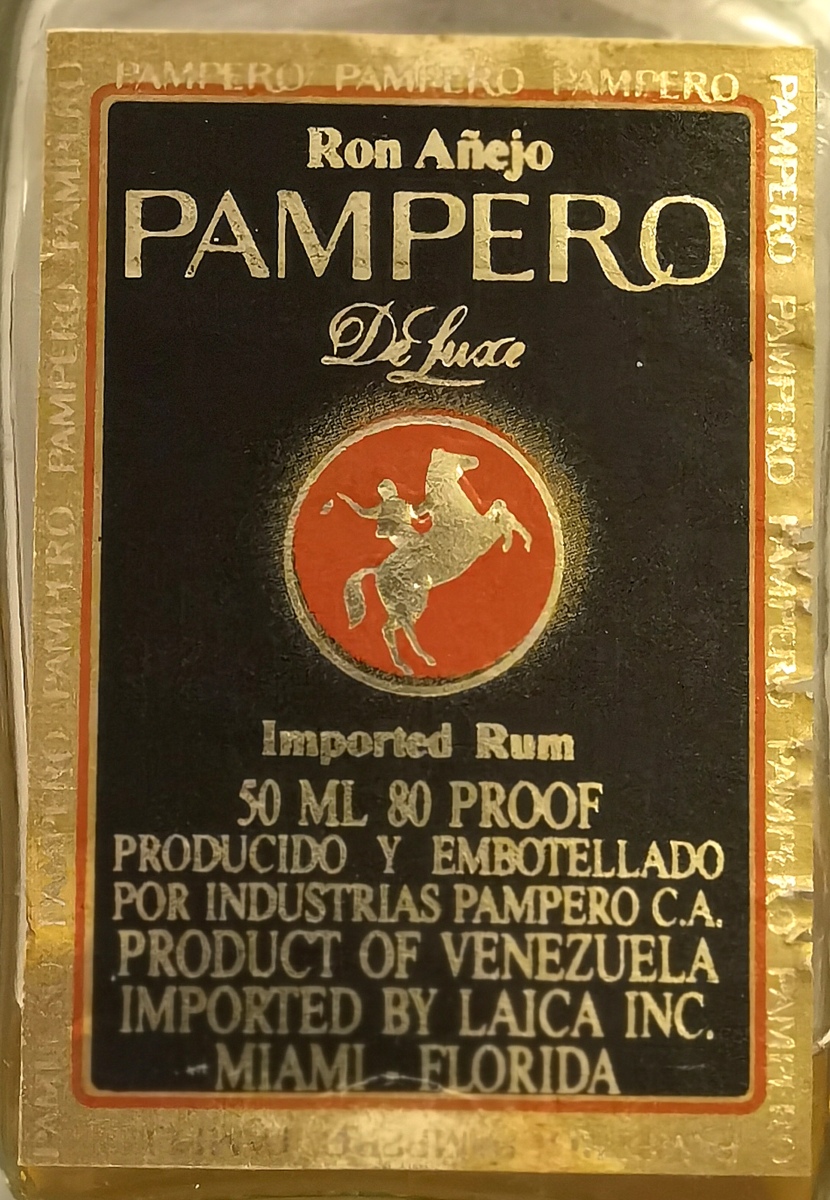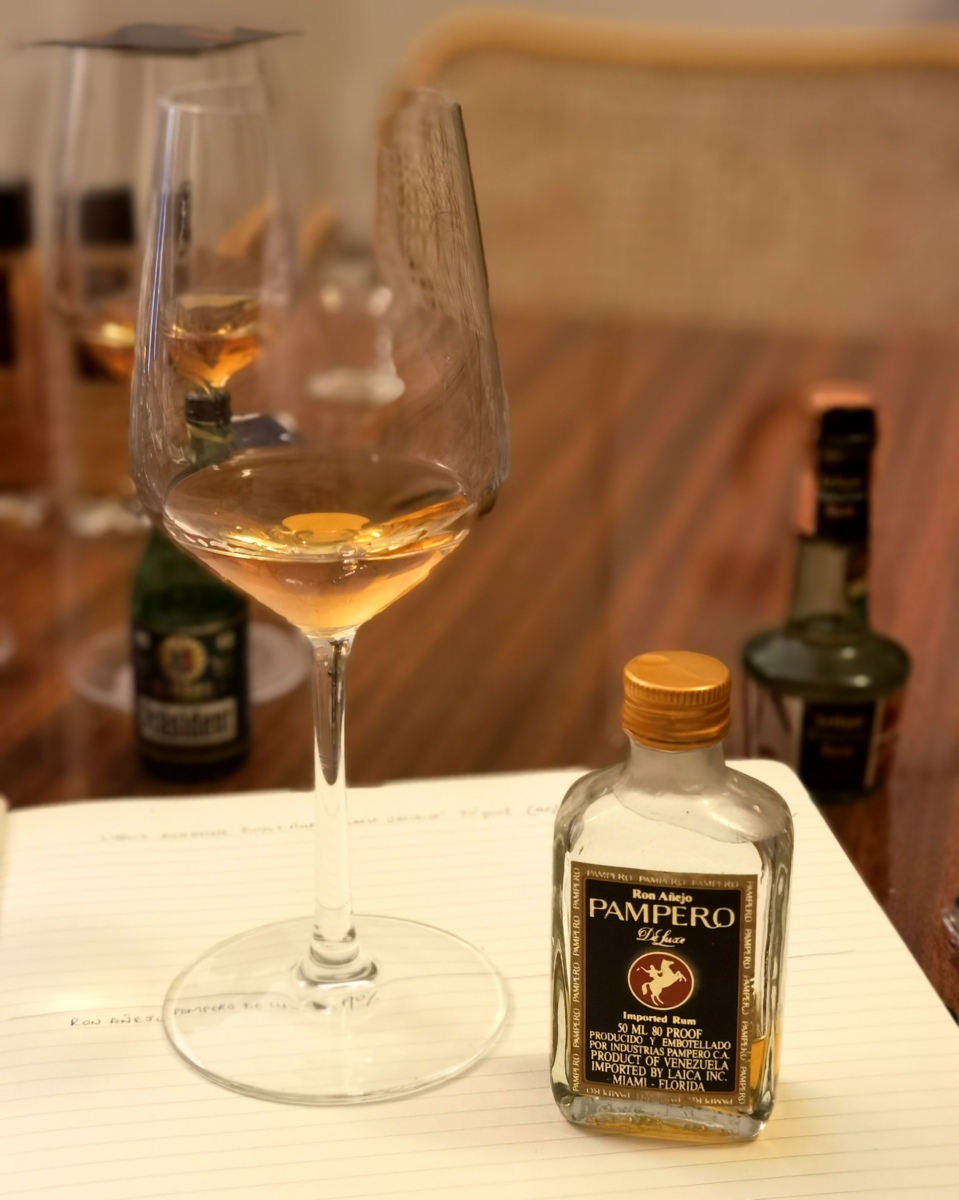Pampero is a lesser known Venezuelan rum brand founded in 1938 by two friends, Alejandro Hernández and Luis Toro, who established their distillery in Caracas, and soon became one of the more popular brands in the country with their light, golden rums. In keeping with the times they eschewed really serious long term ageing, and stuck with the mid range, producing various youngish rons like the Añejo “Extra”, “Dorado”, “White”, “Especial”, “Premium Gold” and so on. These various brands have gone through several name changes over the years and nowadays the line is made up of the Añejo Especial (also known as “Oro” for the yellow label), the Aniversario (well known for its bottle in a leather pouch – I actually have one in my mythical basement somewhere and have yet to open the thing), the Blanco and the Selección 1938 Ron Añejo.
The cowboy on the rearing horse logo is to some extent chanelling a misconception: Venezuelan prairies are referred to as llanos, not pampas, the latter and its gauchos being Argentinian terms, yet this is the image that gives the brand its name. In Venezuela I am led to understand the rum and its brand – still popular after all these years – is called Caballito Frenao (“Rearing Horse”), and sells briskly…even though the brand is no longer in local hands.
In 1991 when the company was sold lock stock and barrels (95% of it all, to be precise) to United Distillers, then a subsidiary of Guinness and which eventually became Diageo, Pampero claimed to be the bestselling golden rum in the world, a claim hardly likely to be either proveable or refutable, even then (you’ll forgive me if I doubt it). United Distillers evidently had some differing opinions on how to market their acquisition, for in the next year some of their stock was shipped to Europe for the indies to play with, which is why we have two Secret Treasures 1992 editions of the Pampero, as well as others from Duval et Cie and Moon Import, also from that year. However, these days it’s all branded sales, most of which takes place in Europe (Spain and Italy) and inside Venezuela, with a smattering of sales to other countries like the US.
 Modern production is molasses based, triple distillation on column stills to near absolute alcohol (96%) and subsequent ageing in white oak cask: they clearly adhere to the light Spanish style rons for that portion of their blend. However, it should be noted that according to their website, their triple distillation process “combines continuous column (light rum), kettle batch (semi-heavy rum) and pot still (heavy rum) to produce a high-quality alcohol,” so it would seem they have more than just a bunch of heavy duty industrial sized columnar stills churning out bland nothingness. However there are few if any references available to speak more to the subject, and even less that tells what the process was like pre-Diageo, to when this version was made.
Modern production is molasses based, triple distillation on column stills to near absolute alcohol (96%) and subsequent ageing in white oak cask: they clearly adhere to the light Spanish style rons for that portion of their blend. However, it should be noted that according to their website, their triple distillation process “combines continuous column (light rum), kettle batch (semi-heavy rum) and pot still (heavy rum) to produce a high-quality alcohol,” so it would seem they have more than just a bunch of heavy duty industrial sized columnar stills churning out bland nothingness. However there are few if any references available to speak more to the subject, and even less that tells what the process was like pre-Diageo, to when this version was made.
The little bottle I found was made for the US market in the 1980s by a spirits importer called Laica, which disappeared from view by 1990; and since the US was still using ounces as a unit of measure on bottle labels until the late 1970s, I’m okay dating this to the decade of big hair, shoulder pads and breakdancing.
Strength – 40%
Colour – Gold
Nose – Nothing excessive or overly sharp. Subtle dusty and cereal-y aromas start the ball rolling. Pleasant — though rather restrained — notes of honey, chocolate, nuts, almonds and molasses, More piquant fruits enter the aromas after some minutes, mostly cherries, bananas and overripe soft apples.
Palate – It’s too thin to make any kind of statement, really, and a lot of what was nosed just up and vanishes. Molasses, some brown sugar, red wine, vanilla, and just enough of a rum profile to stop it from being a throwaway
Finish – Weak, short, faint, is there and gone too quickly to make itself felt. Disappointing.
Thoughts – By now I’ve had enough rums from South America, and from that era, to be unsurprised at how bland the experience is – their skillset is in light age and consummate blending, not fierce hogo or still-bestowed character. One can reasonably ask if back in the day they had added any of that heavier pot still juice to the blend, the way they do now – one suspects not, and unfortunately that leaves a rather anonymous rum behind, which starts decently enough but which ends with a whole lot of nothing to report.
(72/100) ⭐⭐½

